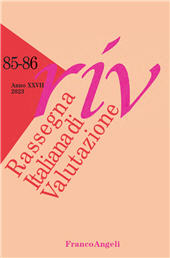La valutazione delle politiche comunitarie in Italia
55-94 p.
rticle reviews the last 30 years of EU multiannual program-ming. The ultimate objective is to capture how the way of interpreting evaluation has changed during this long journey and how the Italian PA has used this 'tool' to increase the effectiveness of policies and strengthen awareness in planning and implementing public investments co-financed by the European Union. In six programming cycles, from 1989-1993 to 2021-2027, evalua-tion has had ups and downs, passing from the utmost marginality to a certain centrality. The approaches and tools put in place by the Euro-pean Commission to make it useful for improving the results of the re-sources invested have been various, and this article attempts to summa-rise them, also in order to continue with momentum in the drive to strengthen public action for which evaluation is the vehicle.
The retro-spective analysis of the different interpretations that the evaluation processes have had in the Structural Funds (mainly ERDF and ESF) and in the rural development policies (EAFRD) allows us to learn some relevant lessons on the most effective strategies and on those that have not proved appropriate.alyses how evaluation acted at the time of the pandemic, what lessons it has left in the scientific community in this particular stage of our recent history, also by means of a survey of insiders and PA staff involved in evaluation processes. Prospects for the near future are pointed out, providing some hints and suggestions for strengthening evaluation as an opportunity to affect the quality of administrative ac-tion in the country system and capable of fostering a cultural change in the management of public affairs. [Publisher's text].
-
Articoli dello stesso fascicolo (disponibili singolarmente)
-
Informazioni
Codice DOI: 10.3280/RIV2023-085004
ISSN: 1972-5027
PAROLE CHIAVE
- European programs, Evaluation culture, Change, Adminis-trative capacity, Pandemic, Future


